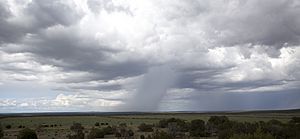Rain follows the plow facts for kids
Imagine a time when people believed that if you started farming in a dry area, it would magically start raining more! This idea was called "Rain follows the plow." It was a popular but wrong theory in the late 1800s, especially in the American West and Australia.
People thought that when farmers tilled the soil and settled in dry places, the weather would change. They believed these areas would become more humid and get more rain. This idea was used to encourage people to move to the Great Plains in the United States, which was once known as the "Great American Desert." It also encouraged farmers to grow wheat in dry parts of South Australia.
The theory said that more people and more farming would bring more rain over time. This would make the land fertile and green. However, later records showed that the theory was based on a mistake. There were a few years of more rain that happened at the same time as people settled. But this was just a coincidence, not because farming caused the rain. Scientists now know that "Rain follows the plow" was just a superstition.
Contents
The Idea Spreads in North America
The "Rain follows the plow" idea became popular in the 1860s and 1870s. This was when people from Europe started moving west of the Missouri River in North America. This area was usually the dividing line between humid and dry parts of the continent.
Early settlers in Nebraska noticed something interesting. The land, which was usually dry and yellow in summer, seemed to be turning green. Some scientists thought this was because of the new settlements and farming.
One supporter of this idea was Cyrus Thomas. He was a scientist who studied people and insects. But he was only an amateur weather expert. After looking at Colorado's history, he believed that the increase in moisture was permanent. He thought it happened exactly when the first settlers started farming the land. Other famous people who supported the theory included Ferdinand Vandeveer Hayden, a geographer, and Samuel Aughey, a professor. Charles Dana Wilber, an author, also wrote about it.
Why People Believed It
Scientists and others had different ideas about why "Rain follows the plow" might work. One common thought was that plowing the soil let its moisture rise into the sky. They also believed that new trees and bushes would increase rainfall. Even smoke from trains, or the metal in train tracks and telegraph wires, were thought to help.
Another idea was that human activity caused more vibrations in the air. These vibrations would create more clouds, leading to rain. This strange belief even led to people trying to make it rain by setting off dynamite in the air across the Great Plains in the 1870s!
Many people, including scientists, land sellers, and settlers, really liked this theory. Some historians think it fit with the idea of "Manifest Destiny." This was a belief that the United States had a special mission to expand and spread its way of life. The theory is partly why so many people moved to the Great Plains quickly in the late 1800s.
William Gilpin, the first governor of Colorado, was a strong supporter. He believed in Manifest Destiny and encouraged people to move west, using this theory as a reason.
What We Know Now
Today, weather scientists understand that more plants and cities can increase rainfall. But this effect is usually very local. It means more rain in one small area might take rain away from nearby places. It cannot change the climate for a whole large region.
Scientists also know that the Great Plains had a few years of more rain than usual when this theory was popular. This happened at the same time as more people were settling there. When the normal dry conditions returned, many homesteaders suffered, especially during events like the Dust Bowl.
In recent years, some studies have looked at how changing grasslands to cornfields in Canada affects weather. One idea is that corn crops release more moisture into the air than grass. This might create more storms and make the water cycle more active in the atmosphere.
Also, in the last part of the 1900s, the Midwest saw cooler summers and more rain. This might be linked to farming practices in the Great Plains. For example, a lot more land is now irrigated in the Plains. This irrigation water evaporates and goes into the atmosphere. Then, it falls as rain over the Midwest, which is downwind.
The Idea Spreads in Australia
At the same time, the "Rain follows the plow" theory was also present in Australia. Farmers in South Australia started moving their farms north from Adelaide into much drier areas.
However, not everyone agreed. As early as 1865, a man named George Goyder warned that rain would not follow the plow. He wrote a famous report about farming in the state.
Despite Goyder's warning, farmers kept talking about growing crops far north, almost to the Northern Territory border. But after more droughts in the 1880s, they realized it wasn't true. Even today, grain crops don't grow much further north than a town called Quorn. This is just as Goyder had advised many years ago.
Images for kids


